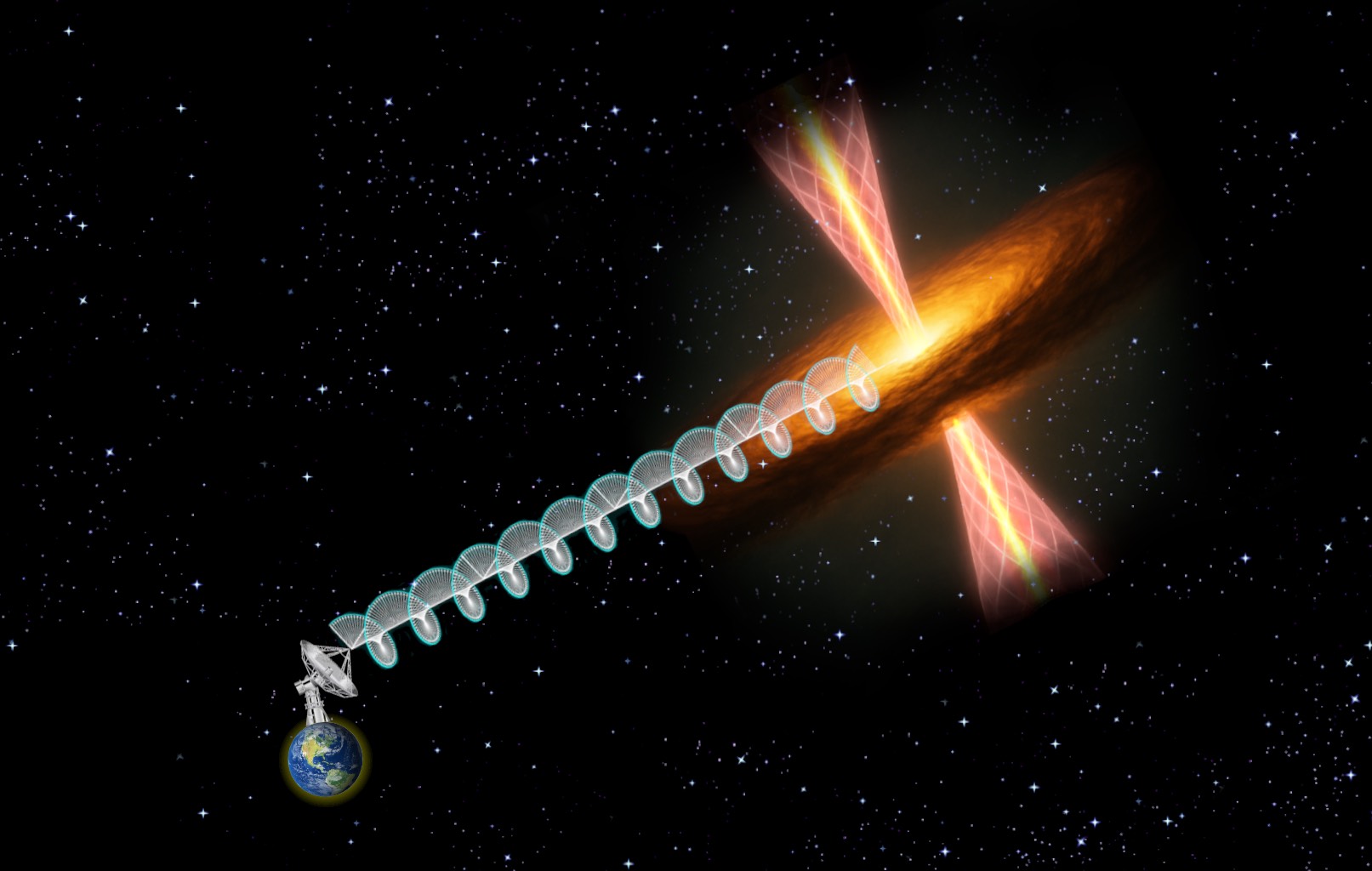17 July 2025

Schematic of circular polarisation being detected in radio waves from a massive protostar surrounded by a disk and driving a bipolar jet. This is an artistic image, not drawn to scale. Credit: AG Cheriyan, IIST
An international team led by astronomers from the Indian Institute of Space Science and Technology (IIST), Thiruvananthapuram, India, has made a remarkable discovery. Radio emission with a special property known as circular polarisation (shown in the schematic image as twisted light beam) has been detected near a massive, young forming star.
Circular polarisation (CP) occurs when the electric and magnetic field vectors of electromagnetic waves – in this case, radio waves – rotate in a circle about the direction in which the waves are travelling through space. This emission offers the first direct clue to the strength of magnetic fields in the immediate surroundings of a forming massive star. This new detection opens an exciting window into our understanding of how massive stars form, which go on to shape entire galaxies.
The discovery, published in The Astrophysical Journal Letters, focuses on a massive protostar named IRAS 18162-2048. A protostar is the earliest known stage of a star that is beginning to form. It is still accumulating gas and dust material from its surroundings. In the early stages, the protostar can also shoot out high-velocity material in opposite directions, known as a bipolar jet.
The protostar under study powers one of the largest and brightest known protostellar jets in our Milky Way galaxy, the HH80-81 jet. It is widely believed that the magnetic field and rotation in the protostellar system are responsible for the ejection of the jet. While magnetic field has been imaged from the jet earlier, this is the first time that hints of magnetic field have been detected from this massive protostar directly. There are very few such measurements of the magnetic field, and one technique that has been used is the measurement of circularly polarised light from the protostar.
“Massive protostars – stars that will evolve to have mass more than 8-10 times that of the Sun – are much harder to study. The circular polarisation we’re looking for is very faint and sporadic, making such measurements very challenging,” explains Amal George Cheriyan from IIST, lead author of the paper. The radio observations were carried out using the National Radio Astronomy Observatory’s (NRAO) Karl G Jansky Very Large Array (VLA) in the USA.
While strong magnetic fields have been observed earlier in low-mass protostars that go on to form stars like our Sun, measuring such fields around massive protostars has remained elusive – until now. “This is the first inference of the magnetic field strength using circular polarisation in radio waves from a massive protostar,” said Prof Sarita Vig of the Indian Institute of Space Science and Technology (IIST), Thiruvananthapuram, who conceptualised the work. It supports the idea that the way jets are launched may be universal – from low-mass stars to black holes.
“The detection of circular polarisation is an exceptionally rare and challenging feat – even in active galactic nuclei (AGNs), where conditions are extreme, but better investigated,” said Prof Nirupam Roy from the Indian Institute of Science (IISc), Bengaluru, India. “Observing it in the environment of a massive protostar, buried in dense gas and dust, is even more difficult, making this result very remarkable,” added Prof Samir Mandal of IIST.
This study produced the following key results:
1. First-ever detection of circular polarisation from a massive protostar
For the first time, astronomers have detected circular polarisation from a massive protostar. This rare signal has previously been seen in black holes and low mass protostars, and now links massive star formation to the same cosmic processes.
2. Inferring the magnetic field near a massive protostar
The new data allowed researchers to infer the magnetic field near the protostar to be about 20–35 Gauss, roughly 100 times stronger than Earth’s magnetic field. These values match what scientists have observed in low-mass protostars, hinting at a common magnetic origin.
3. Evidence for a universal jet-launching mechanism
The detection supports a long-standing theory – that powerful jets from stars and black holes are driven by the same magnetic engine. By detecting circular polarisation, this study provides strong evidence that the physics behind jet formation is universal across different astrophysical environments.
Amal George Cheriyan is a PhD student under Prof Sarita Vig at the Indian Institute of Space Science and Technology (IIST), Thiruvananthapuram, India. They carried out this work in collaboration with Prof Nirupam Roy from the Indian Institute of Science (IISc), Bengaluru, India; Prof Samir Mandal, IIST; and other scientists from the Institute of Radio Astronomy and Astrophysics (IRyA) of the National Autonomous University of Mexico (UNAM), Mexico, and Instituto de Astronomıa Teorica y Experimental (IATE) of the Universidad Nacional de Córdoba (UNC) Córdoba, Argentina.
REFERENCE:
AG Cheriyan, S Vig, Nirupam Roy, Samir Mandal, C Carrasco-González, A Rodríguez-Kamenetzky, and A Pasetto, First Detection of Circular Polarization in Radio Continuum Toward a Massive Protostar, The Astrophysical Journal Letters (2025).
https://doi.org/10.3847/2041-8213/ade99b
CONTACT:
Sarita Vig (IIST) – sarita.vig@gmail.com
Amal G Cherian (IIST) – amalgeorgecheriyan@gmail.com
Nirupam Roy (IISc) – nroy@iisc.ac.in


